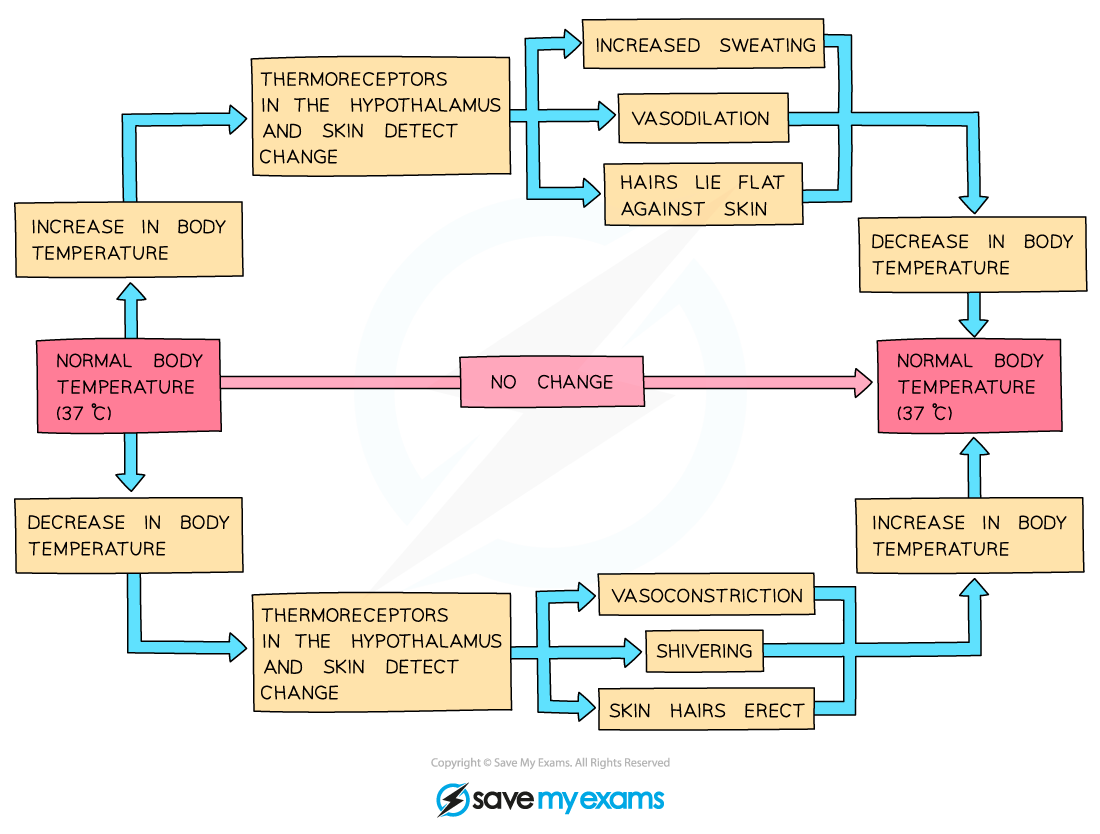The Role of Skin in Temperature Regulation (Edexcel IGCSE Biology) : Revision Note
Did this video help you?
The Role of Skin in Temperature Regulation
The skin is our largest sense organ
It contains many different receptors that enable us to detect various external stimuli, including touch, pressure, pain, heat and cold
Structures within the skin also play an important role in regulating body temperature (an example of homeostasis)

Human skin contains structures involved in processes that can increase or reduce heat loss to the surroundings
Cooling mechanisms in humans
Vasodilation of skin capillaries
Heat exchange (both during warming and cooling) occurs at the body's surface as this is where the blood comes into closest proximity to the environment
One way to increase heat loss is to supply the capillaries in the skin with a greater volume of blood, which then loses heat to the environment via radiation
Arterioles (small vessels that connect arteries to capillaries) have muscles in their walls that can relax or contract to allow more or less blood to flow through them
During vasodilation, these muscles relax, causing the arterioles near the skin to dilate (get wider) and allowing more blood to flow through capillaries
Sweating
Sweat is secreted by sweat glands
This cools the skin by evaporation which uses heat energy from the body to convert liquid water into water vapour
Flattening of hairs
The hair erector muscles in the skin relax, causing hairs to lie flat
This stops them from forming an insulating layer by trapping air and allows air to circulate over the skin and allows heat to leave by radiation

Responses in the skin when the body temperature is too high and needs to decrease
Warming mechanisms in humans
Vasoconstriction of skin capillaries
One way to decrease heat loss is to supply the capillaries in the skin with a smaller volume of blood, minimising the loss of heat to the environment via radiation
During vasoconstriction, the muscles in the arteriole walls contract, causing the arterioles near the skin to constrict (get smaller) and allowing less blood to flow through capillaries
Vasoconstriction is not, strictly speaking, a 'warming' mechanism as it does not raise the temperature of the blood but instead reduces heat loss from the blood as it flows through the skin
Shivering
This is a reflex action in response to a decrease in core body temperature
Muscles contract in a rapid and regular manner
The exothermic metabolic reactions required to power this shivering generate sufficient heat to warm the blood and raise the core body temperature
Erection of hairs
The hair erector muscles in the skin contract, causing hairs to stand on end
This forms an insulating layer over the skin's surface by trapping air between the hairs and stops heat from being lost by radiation

Responses in the skin when body temperature is too low and needs to increase
The core body temperature of humans is kept close to 37°C
This is very tightly controlled as a change in core body temperature of more than 2°C can be fatal
For this reason, the human body must be able to make a coordinated response to any rise or fall in body temperature
Temperature receptors (also known as thermoreceptors) in the skin and hypothalamus (a part of the brain) can detect minute changes in body temperature
The brain then coordinates a cooling or heating response, depending on what is required

Temperature regulation is an example of homeostasis as it must be maintained within a constant range

You've read 0 of your 5 free revision notes this week
Sign up now. It’s free!
Did this page help you?
